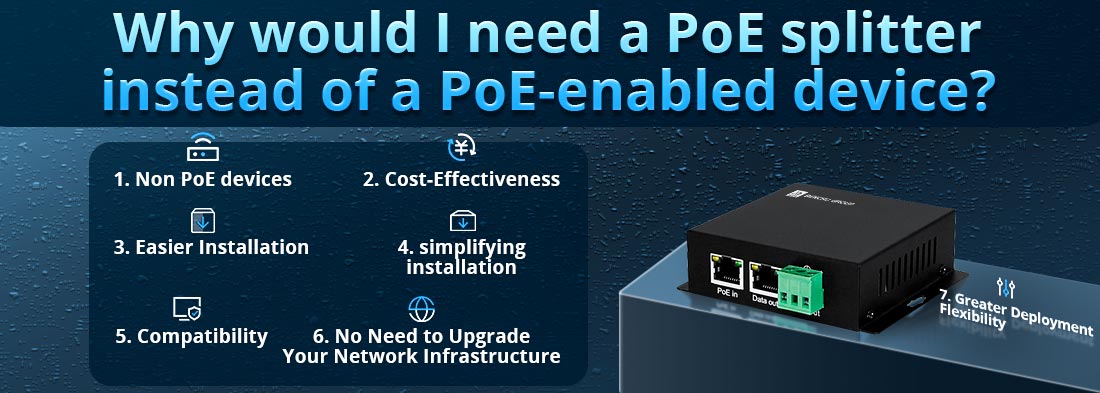
ستحتاج إلى تقسيم Poe بدلاً من جهاز يدعم PoE في المواقف التي لا تدعم فيها أجهزتك الحالية الطاقة على Ethernet (POE) ولكن لا تزال تتطلب اتصالات الطاقة والبيانات. يتيح لك Splitter Poe دمج الأجهزة غير PoE في شبكة تعمل ببور ، مما يوفر العديد من المزايا من حيث التكلفة والمرونة وكفاءة النشر.
الأسباب الرئيسية لاستخدام فاصل Poe بدلاً من جهاز يدعم POE
1. استخدام الأجهزة غير الضيقة في شبكة POE
--- إذا كان لديك بالفعل أجهزة غير بوي (على سبيل المثال ، كاميرات IP أو نقاط الوصول أو محولات Raspberry Pi أو Media) ولا تريد استبدالها بإصدارات متوافقة مع POE ، أ بوي فاصل يمكّنك من تشغيلها عبر Ethernet.
--- بدلاً من شراء أجهزة جديدة تدعم POE ، يمكنك متابعة استخدام المعدات الحالية الخاصة بك مع الاستفادة من البنية التحتية POE.
2. فعالية التكلفة
--- غالبًا ما تكون الأجهزة التي تدعم PoE (مثل كاميرات Poe IP أو هواتف Poe Voip أو نقاط الوصول إلى PoE) أغلى ثمناً من نظرائها غير بوي.
--- يعتبر فاصل Poe بديلاً أقل من التكلفة لترقية جميع أجهزتك ، مما يجعلها حلًا مناسبًا للميزانية لدمج الأجهزة غير PoE في إعداد يعمل بزاوية POE.
3. التثبيت الأسهل في المواقع بدون منافذ الطاقة
--- غالبًا ما يتم تثبيت العديد من أجهزة الشبكات (على سبيل المثال ، كاميرات المراقبة ، ونقاط الوصول ، أو اللافتات الرقمية) في أماكن يصعب الوصول إليها مثل الأسقف أو الأعمدة الخارجية أو المناطق النائية.
--- قد يكون تشغيل كابل طاقة منفصل لهذه المواقع أمرًا صعبًا ومكلفًا.
--- يتيح لك فاصل Poe توصيل كل من الطاقة والبيانات عبر كابل Ethernet واحد ، مما يلغي الحاجة إلى منافذ كهربائية قريبة.
4. تقليل فوضى الكابل ومحولات الطاقة
بدون وجود فاصل Poe ، تحتاج الأجهزة غير البير إلى كلاهما:
1. كابل إيثرنت للبيانات.
2. محول طاقة منفصل متصل بمنفذ الطاقة.
يزيل Splitter Poe الحاجة إلى محول طاقة منفصل ، ويقلل من فوضى الكابلات وتبسيط التثبيت ، وهو أمر مفيد بشكل خاص في بيئات الكابلات المنظمة.
5. التوافق مع أجهزة الجهد المنخفض
--- بعض الأجهزة الصغيرة ، مثل Raspberry Pi ، أو أجهزة الاستشعار ، أو وحدات التحكم المدمجة ، تتطلب مستويات محددة من جهد التيار المستمر (على سبيل المثال ، 5 فولت ، 9 فولت ، أو 12 فولت).
--- يمكن أن يقوم فاصل Poe بتحويل جهد Poe القياسي (48 فولت) إلى جهد DC أقل ، مما يجعله مناسبًا للأجهزة التي لا تستطيع التعامل مع إدخال POE المباشر.
6. لا حاجة لترقية البنية التحتية للشبكة الخاصة بك
--- إذا كان لديك مفتاح غير بوي موجود وتحتاج إلى تشغيل أجهزة POE ، فستحتاج عادةً إلى استبدال المفتاح بمفتاح PoE.
--- بدلاً من ذلك ، يمكنك استخدام مجموعة Poe Injector + Poe Flitter لتوفير الطاقة لأجهزة محددة غير بوي دون ترقية البنية التحتية للشبكة بأكملها.
7. مرونة نشر أكبر
--- بعض الأجهزة المتخصصة لا تتوفر إصدارات تدعم POE (على سبيل المثال ، بعض أجهزة إنترنت الأشياء ، أو الأنظمة المضمّنة المخصصة خصيصًا ، أو معدات شبكة الملكية).
--- يتيح فاصل Poe استخدام أي جهاز يعمل به Ethernet في أ شبكة بومما يجعل نشرك أكثر تنوعا.
متى يتم اختيار فاصل Poe مقابل جهاز يدعم Poe
| سيناريو | استخدم فاصل بو | استخدم جهازًا يدعم POE |
| أنت تملك بالفعل أجهزة غير بوي وتريد دمجها في شبكة POE. | ✅ | ❌ |
| تريد تقليل التكاليف دون استبدال الأجهزة الحالية. | ✅ | ❌ |
| يتطلب جهازك جهد DC محدد (على سبيل المثال ، 5V ، 9V ، 12V). | ✅ | ❌ |
| يتم تثبيت جهازك في موقع بدون منفذ للطاقة. | ✅ | ✅ |
| أنت تقوم ببناء شبكة جديدة وتريد أبسط حل POE. | ❌ | ✅ |
| أجهزتك متوافقة بالفعل مع POE. | ❌ | ✅ |
خاتمة
يعد Splitter Poe هو الخيار الأفضل عندما تحتاج إلى تشغيل الأجهزة غير الوعرة في شبكة POE ، وتقليل تكاليف التثبيت ، والقضاء على محولات الطاقة الإضافية ، وتبسيط النشر في المواقع دون سهولة الوصول إلى منافذ الطاقة. إنه بديل فعال من حيث التكلفة لشراء الأجهزة التي تدعم POE ويوفر مرونة أكبر لاستخدام مزيج من معدات PoE وغير Poe.